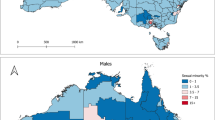We examine the association of community linguistic diversity with non-spousal sexual activity in Uganda. We conducted a survey on rates of sexual contact in last 12 months among 1709 respondents age 18–60 living in Uganda in early 2001. Households were selected at random from Demographic and Health Survey (DHS) 2000 household sampling frame listings in 12 districts and 120 clusters. Household listings described the principal language spoken by every household in the cluster. Sexual contact was reported by 26 vs. 13% of unmarried women in multilingual vs. monolingual clusters respectively. Extramarital sexual contact occurred for 29 vs. 16% for married men in multilingual vs. monolingual clusters respectively. These results were robust to multivariate models which included confounders such as urbanity, and cluster distance to market places, cinemas, and transportation. Our results suggest a robust association between residence in a multilinguistic community and higher rates of non-spousal sex.
Similar content being viewed by others
Notes
This strategy is not perfect because in Uganda there are groups that claim differing ethnicity, but share common language. If anything, this limitation makes it less likely that we will confirm our hypothesis, because there could be ethnic variation that is not captured by a measure of language variation.
REFERENCES
Basu, A. M. (1998). Poverty and AIDS: The vicious circle. In M. Livi-Bacci and G. De Santis (Eds.), Population and poverty in the developing world (pp. 145–160). Oxford: Oxford University Press.
Bishai, D., Pariyo, G., Ainsworth, M., and Hill, K. (2004). Determinants of personal demand for an AIDS vaccine in Uganda. Bulletin of The World Health Organization, 82, 652–660.
Cutler, D. M., Elmendorf, D., and Zeckhauser, R. (1993). Demographic characteristics and the public bundle. Public Finance, 48, 178–198.
Easterly, W., and Levine, R. (1997). Africa’s growth tragedy: Policies and ethnic divisions. Quarterly Journal of Economics, 112(4), 1203–1250.
Fang, J., Madhavan, S., Bosworth, W., and Alderman, M. H. (1998). Residential segregation and mortality in New York City. Social Science and Medicine, 47(4), 469–476.
Faris, R. E., and Dunham, H. W. (1939). Mental disorders in urban areas. Chicago: Chicago University Press.
Francoeur, R. T., Perper, T., Scherzer, N. A., Sellmer, G., and Cornog, M. (1991). A descriptive dictionary and atlas of sexology. (p. 130). New York: Greenwood Press.
Franzini, L., and Spears, W. (2003). Contributions of social context to inequalities in years of life lost to heart disease in Texas, USA. Social Science and Medicine, 57, 1847–1861.
Franzoni, l., and Spears, W. (2003). Contributions of social context to inequalities in years of life lost to heart disease in Texas, USA. Social Science and Medicine, 57, 1847–1861.
Green, E. (2003). Testimony of Edward C. Green Before African Subcommittee U.S. Senate. Washington, DC: U.S. Senate.
Guilamo-Ramos, V., Jaccard, J., Pena, J., and Goldberg, V. (2005). Acculturation-related variables, sexual initiation, and subsequent sexual behavior among Puerto Rican, Mexican, and Cuban youth. Health Psychology, 24(1), 88–95.
Halpern, D., and Nazroo, J. (2000). The ethnic density effect: results from a national community survey of England and Wales. International Journal of Social Psychiatry, 46(1), 34–46.
Heuveline, P. (2004). The Structure of an Epidemic: A Model of AIDS Transmission in Sub Saharan Africa. Paper presented at the Population Association of America, Boston, MA.
Hogle, J. (2002). What Happened in Uganda? Declining HIV Prevalence, Behavior Change, and the National Response. Washington, DC: U.S. Agency for International Development.
La Ferrara, E. (2003). Kin Groups and Reciprocity: A Model of Credit Transactions in Ghana. American Economic Review, 93, 1730–1751.
Montgomery, M., and Casterline, J. (1996). Social learning, social influence, and new models of fertility. Population and Development Review, 22(Suppl), 151–175.
Patil, P. (2003). Community Contextual and Environmental Determinants of HIV Risk in Rakai District, Uganda. Baltimore, MD: Johns Hopkins University.
Porter, L., Hao, L., Bishai, D., and Gray, R. (2004). HIV Status and Union Dissolution in Rakai, Uganda. Demography, 41(3), 465–482.
Poterba, J. (1997). Demographic Structure and the Political Economy of Public Education. Journal of Public Policy and Management, 16, 48–66.
Vandello, J. A., and Cohen, D. (2003). Male honor and female fidelity: implicit cultural scripts that perpetuate domestic violence. Journal of Personality and Social Psychology, 84, 997–1010.
Wilson, J., Kuehn, R., and Beach, F. (1963). Modifications in the Sexual Behavior of Male Rats Produced by Changing the Stimulus Female. Journal of Comparative and Physiological Psychology, 56, 636–644.
ACKNOWLEDGMENTS
The authors wish to thank the Johns Hopkins Center for AIDS Research for supporting this research (5P30AI042855-04). Helpful comments from seminar participants at the Harvard Center for Population and Development Studies, Brown University Population Studies and Training Center, and from Michael McQuestion and Saifuddin Ahmed are gratefully acknowledged. Finally, we thank Martha Ainsworth, the International AIDS Vaccine Initiative, and the European Union, for their contributions to data collection.
Author information
Authors and Affiliations
Corresponding author
Rights and permissions
About this article
Cite this article
Bishai, D., Patil, P., Pariyo, G. et al. The Babel Effect: Community Linguistic Diversity and Extramarital Sex in Uganda. AIDS Behav 10, 369–376 (2006). https://doi.org/10.1007/s10461-006-9097-3
Published:
Issue Date:
DOI: https://doi.org/10.1007/s10461-006-9097-3




